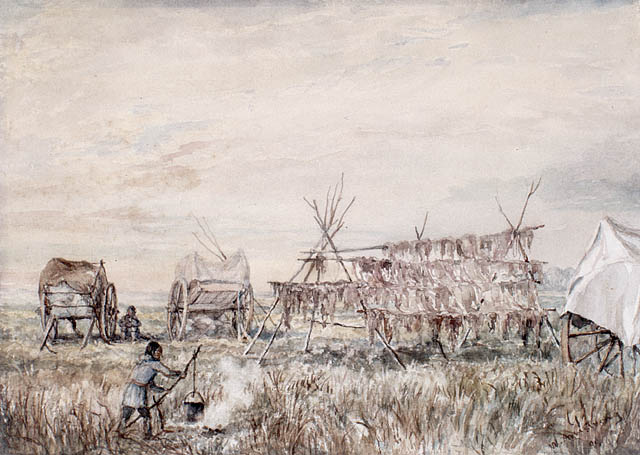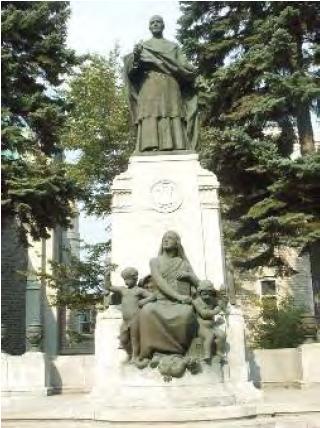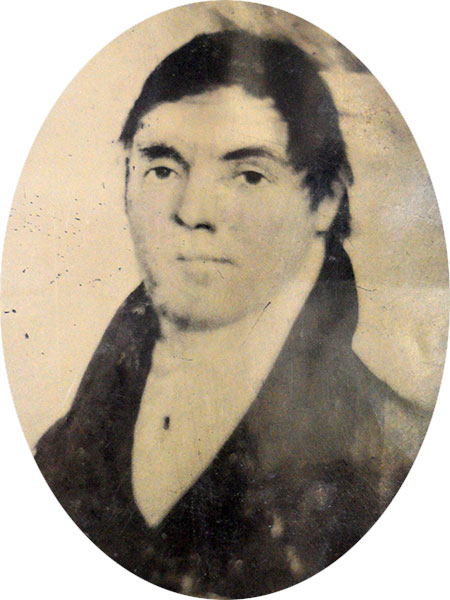|
St. François Xavier, Manitoba
St. François Xavier is an unincorporated urban centre located in the Rural Municipality of St. François Xavier, Manitoba, Canada. It is located about 15 km west of the city of Winnipeg on the Assiniboine River. Settled around 1824 as Grantown, it is the second oldest settlement in Manitoba. History The area of current-day St. François Xavier, commonly known as White Horse Plains (''La Prairie du Cheval Blanc''), was home to several distinct First Nations , such as the Cree and the Dakota. The lands in the area supported numerous buffalo and other game animals. Around 1824, Cuthbert Grant, who had recently led the Métis in the Battle of Seven Oaks, arrived in the area and was soon joined by many Métis families. The settlement was thereby founded, and named ''Grantown'' after Grant. The Métis have since had a noticeable role in the municipality and throughout the province. In 1851, Father Louis-François Richer Laflèche accompanied the Métis buffalo hunters from t ... [...More Info...] [...Related Items...] OR: [Wikipedia] [Google] [Baidu] |
Manitoba
Manitoba ( ) is a Provinces and territories of Canada, province of Canada at the Centre of Canada, longitudinal centre of the country. It is Canada's Population of Canada by province and territory, fifth-most populous province, with a population of 1,342,153 as of 2021, of widely varied landscape, from arctic tundra and the Hudson Bay coastline in the Northern Region, Manitoba, north to dense Boreal forest of Canada, boreal forest, large freshwater List of lakes of Manitoba, lakes, and prairie grassland in the central and Southern Manitoba, southern regions. Indigenous peoples in Canada, Indigenous peoples have inhabited what is now Manitoba for thousands of years. In the early 17th century, British and French North American fur trade, fur traders began arriving in the area and establishing settlements. The Kingdom of England secured control of the region in 1673 and created a territory named Rupert's Land, which was placed under the administration of the Hudson's Bay Company. Rupe ... [...More Info...] [...Related Items...] OR: [Wikipedia] [Google] [Baidu] |
National Topographic System
The National Topographic System or NTS is the system used by Natural Resources Canada for providing general purpose topographic maps of the country. NTS maps are available in a variety of scales, the standard being 1:50,000 and 1:250,000 scales. The maps provide details on landforms and terrain, lakes and rivers, forested areas, administrative zones, populated areas, roads and railways, as well as other man-made features. These maps are currently used by all levels of government and industry for forest fire and flood control (as well as other environmental issues), depiction of crop areas, right-of-way, real estate planning, development of natural resources and highway planning. To add context, land area outside Canada is depicted on the 1:250,000 maps, but not on the 1:50,000 maps. History Topographic mapping in Canada was originally undertaken by many different agencies, with the Canadian Army’s Intelligence Branch forming a survey division to create a more standardized mappi ... [...More Info...] [...Related Items...] OR: [Wikipedia] [Google] [Baidu] |
Métis Buffalo Hunt
The Métis ( ; Canadian ) are Indigenous peoples who inhabit Canada's three Prairie Provinces, as well as parts of British Columbia, the Northwest Territories, and the Northern United States. They have a shared history and culture which derives from specific mixed European (primarily French) and Indigenous ancestry which became a distinct culture through ethnogenesis by the mid-18th century, during the early years of the North American fur trade. In Canada, the Métis, with a population of 624,220 as of 2021, are one of three major groups of Indigenous peoples that were legally recognized in the Constitution Act of 1982, the other two groups being the First Nations and Inuit. Smaller communities who self-identify as Métis exist in Canada and the United States, such as the Little Shell Tribe of Chippewa Indians of Montana. The United States recognizes the Little Shell Tribe as an Ojibwe Native American tribe. Alberta is the only Canadian province with a recognized Métis Nati ... [...More Info...] [...Related Items...] OR: [Wikipedia] [Google] [Baidu] |
Louis-François Richer Laflèche
Louis-François Laflèche, (September 4, 1818 – July 14, 1898), was a Catholic bishop of the diocese of Trois-Rivières, in the province of Quebec, Canada. Early life and career He was born on September 4, 1818, in the village of Sainte-Anne-de-la-Pérade to Louis-Modeste Richer dit Laflèche and Marie-Anne Richer dit Laflèche (née Joubin dit Boisvert). His family held the secondary surname of Laflèche because their ancestor, Jean Richer, was from an area in France called La Flèche, near Anjou. Laflèche studied at the Nicolet Seminary College in Nicolet, Quebec from 1831 to 1839. Following his education, he taught classics and science while continuing courses in theology. He was ordained a priest on January 7, 1844. In 1844, he headed a mission near the Red River of the North. As a missionary Oblate Laflèche educated himself in three Native American languages spoken in the North-Western Territory: Cree, Chipewyan, and Anishinaabe. He was the first to reduce the Chip ... [...More Info...] [...Related Items...] OR: [Wikipedia] [Google] [Baidu] |
Battle Of Seven Oaks
The Battle of Seven Oaks was a violent confrontation in the Pemmican War between the Hudson's Bay Company (HBC) and the North West Company (NWC), rivals in the North American fur trade, fur trade, that took place on 19 June 1816, the climax of a long dispute in western Canada. The Métis people (Canada), Métis people fought for the North West Company, and they called it "the Victory of Frog Plain" (''la Victoire de la Grenouillère''). Background Miles MacDonell was the governor of the Red River Colony in 1814, the area around Winnipeg, Manitoba. He issued the Pemmican Proclamation which prohibited export of pemmican from the colony for the next year. It was meant to guarantee adequate supplies for the Hudson's Bay Colony, but the North West Company viewed it as a ploy by the Thomas Douglas, 5th Earl of Selkirk, Earl of Selkirk to monopolize the commodity, which was important to the North West Company. The Métis people (Canada), Métis did not acknowledge the authority of the ... [...More Info...] [...Related Items...] OR: [Wikipedia] [Google] [Baidu] |
Métis
The Métis ( ; Canadian ) are Indigenous peoples who inhabit Canada's three Prairie Provinces, as well as parts of British Columbia, the Northwest Territories, and the Northern United States. They have a shared history and culture which derives from specific mixed European (primarily French) and Indigenous ancestry which became a distinct culture through ethnogenesis by the mid-18th century, during the early years of the North American fur trade. In Canada, the Métis, with a population of 624,220 as of 2021, are one of three major groups of Indigenous peoples that were legally recognized in the Constitution Act of 1982, the other two groups being the First Nations and Inuit. Smaller communities who self-identify as Métis exist in Canada and the United States, such as the Little Shell Tribe of Chippewa Indians of Montana. The United States recognizes the Little Shell Tribe as an Ojibwe Native American tribe. Alberta is the only Canadian province with a recognized Métis Nati ... [...More Info...] [...Related Items...] OR: [Wikipedia] [Google] [Baidu] |
Cuthbert Grant
Cuthbert James Grant (1793 – July 15, 1854) was a prominent Métis people (Canada), Métis leader of the early 19th century. His father was also called Cuthbert Grant. Life Cuthbert James Grant was born in 1793 at Fort Tremblant, a North West Company trading post located near the present-day town of Togo, Saskatchewan, where his father was a manager. His father was Cuthbert Grant Sr., a North West Company partner, and his mother was Métis, Margaret Son-gabo-ki-che-ta Grant, Utinwassis Cree Woman. In 1801, at the age of 8, he was sent to be educated, perhaps to Scotland, though this is uncertain. It is not known exactly when he returned to Western Canada, but in 1812, he entered the service of the North West Company at the age of 19. He then travelled with the spring brigade to the ''Pays d'en Haut'', the "high country" of the northwest. He was recognized as a leader of the Métis people, and became involved in the bitter struggle between the Nor'westers and the Hudson's Bay ... [...More Info...] [...Related Items...] OR: [Wikipedia] [Google] [Baidu] |
Bison
Bison are large bovines in the genus ''Bison'' (Greek: "wild ox" (bison)) within the tribe Bovini. Two extant and numerous extinct species are recognised. Of the two surviving species, the American bison, ''B. bison'', found only in North America, is the more numerous. Although colloquially referred to as a buffalo in the United States and Canada, it is only distantly related to the true buffalo. The North American species is composed of two subspecies, the Plains bison, ''B. b. bison'', and the wood bison, ''B. b. athabascae'', which is the namesake of Wood Buffalo National Park in Canada. A third subspecies, the eastern bison (''B. b. pennsylvanicus'') is no longer considered a valid taxon, being a junior synonym of ''B. b. bison''. References to "woods bison" or "wood bison" from the eastern United States refer to this subspecies, not ''B. b. athabascae'', which was not found in the region. The European bison, ''B. bonasus'', or wisent, or zubr, or colloquially European buff ... [...More Info...] [...Related Items...] OR: [Wikipedia] [Google] [Baidu] |
Sioux
The Sioux or Oceti Sakowin (; Dakota language, Dakota: Help:IPA, /otʃʰeːtʰi ʃakoːwĩ/) are groups of Native Americans in the United States, Native American tribes and First Nations in Canada, First Nations peoples in North America. The modern Sioux consist of two major divisions based on Siouan languages, language divisions: the Dakota people, Dakota and Lakota people, Lakota; collectively they are known as the Očhéthi Šakówiŋ ("Seven Council Fires"). The term "Sioux" is an exonym created from a French language, French transcription of the Ojibwe language, Ojibwe term "Nadouessioux", and can refer to any ethnic group within the Great Sioux Nation or to any of the nation's many language dialects. Before the 17th century, the Dakota people, Santee Dakota (; "Knife" also known as the Eastern Dakota) lived around Lake Superior with territories in present-day northern Minnesota and Wisconsin. They gathered wild rice, hunted woodland animals and used canoes to fish. Wars ... [...More Info...] [...Related Items...] OR: [Wikipedia] [Google] [Baidu] |
Cree
The Cree ( cr, néhinaw, script=Latn, , etc.; french: link=no, Cri) are a Indigenous peoples of the Americas, North American Indigenous people. They live primarily in Canada, where they form one of the country's largest First Nations in Canada, First Nations. In Canada, over 350,000 people are Cree or have Cree ancestry. The major proportion of Cree in Canada live north and west of Lake Superior, in Ontario, Manitoba, Saskatchewan, Alberta and the Northwest Territories. About 27,000 live in Quebec. In the United States, Cree people historically lived from Lake Superior westward. Today, they live mostly in Montana, where they share the Rocky Boy Indian Reservation with Ojibwe (Chippewa) people. The documented westward migration over time has been strongly associated with their roles as traders and hunters in the North American fur trade. Sub-groups / Geography The Cree are generally divided into eight groups based on dialect and region. These divisions do not necessarily r ... [...More Info...] [...Related Items...] OR: [Wikipedia] [Google] [Baidu] |
First Nations In Manitoba
First Nations in Manitoba constitute of over 130,000 registered people, about 60% of whom live on reserve. There are 63 First Nations in the province and five indigenous linguistic groups. The languages are Nēhiyawēwin, Ojibwe, Dakota, Oji-Cree, and Dene. First Nations are listed by ''common usage'' names but other names may be applied in certain areas; for example, " Cree Nation" and "First Nation" is applied to certain bands on the same reserve. Reserves in Manitoba There are about 63 reserves in Manitoba: * Barren Lands First Nation * Berens River First Nation * Birdtail Sioux First Nation * Bloodvein First Nation * Brokenhead Ojibway Nation * Buffalo Point First Nation * Bunibonibee Cree Nation * Canupawakpa Dakota First Nation * Chemawawin Cree Nation * Cross Lake First Nation * Dakota Plains First Nation * Dakota Tipi First Nation * Dauphin River First Nation * Ebb and Flow First Nation * Fairford First Nation * Fisher River Cree Nation * Fox Lake Cree Nation * ... [...More Info...] [...Related Items...] OR: [Wikipedia] [Google] [Baidu] |
Buffalo Meat Drying, White Horse Plains, Red River
Buffalo most commonly refers to: * Bubalina, including most "Old World" buffalo, such as water buffalo * Bison, including the American buffalo * Buffalo, New York Buffalo or buffaloes may also refer to: Animals * Bubalina, a subtribe of the tribe Bovini within the subfamily Bovinae ** African buffalo or Cape Buffalo (''Syncerus caffer'') ** ''Bubalus'', a genus of bovines including various water buffalo species ***Wild water buffalo (''Bubalus arnee'') *** Water buffalo (''Bubalus bubalis'') **** Italian Mediterranean buffalo, a breed of water buffalo *** Anoa *** Tamaraw (''Bubalus mindorensis'') ***''Bubalus murrensis'', an extinct species of water buffalo that occupied riverine habitats in Europe in the Pleistocene * Bison, large, even-toed ungulates in the genus ''Bison'' within the subfamily Bovinae **American bison (''Bison bison''), also commonly referred to as the American buffalo or simply "buffalo" in North America **European bison is also known as the European buffalo ... [...More Info...] [...Related Items...] OR: [Wikipedia] [Google] [Baidu] |






